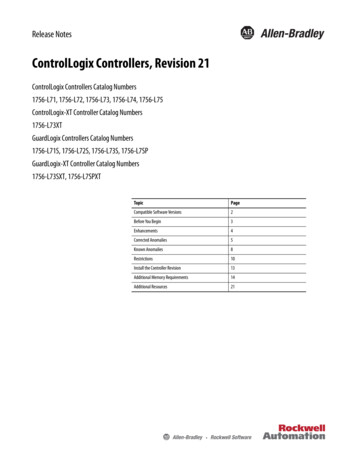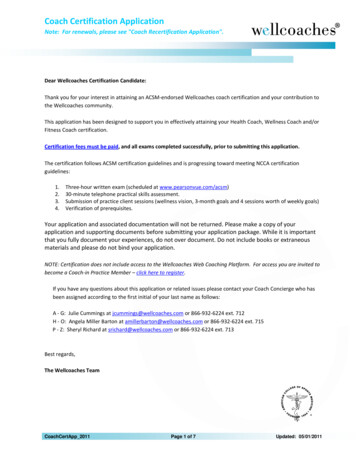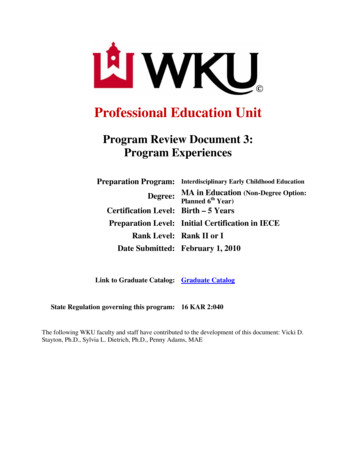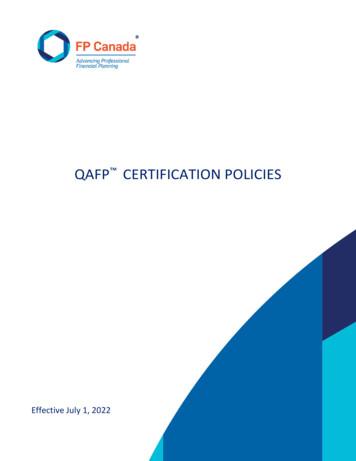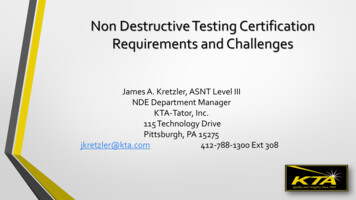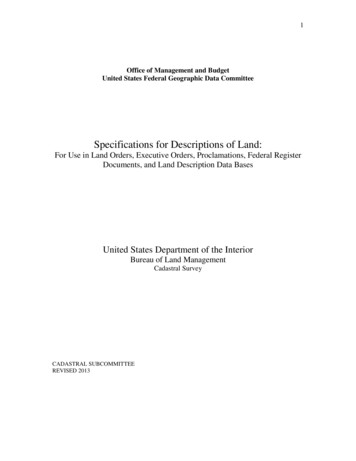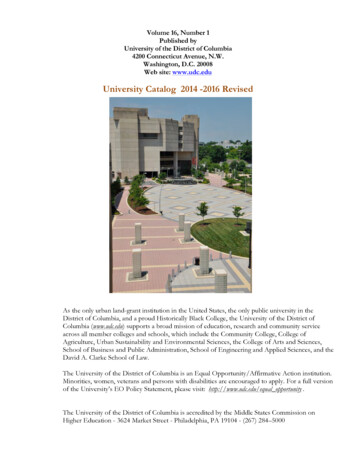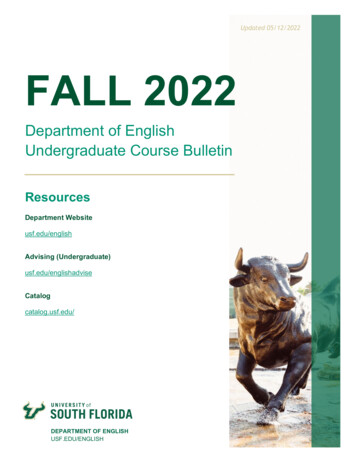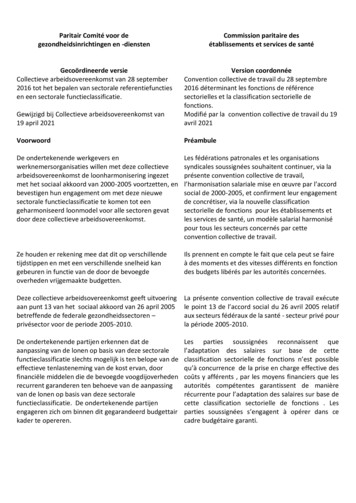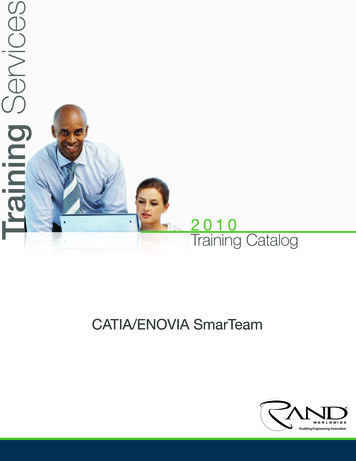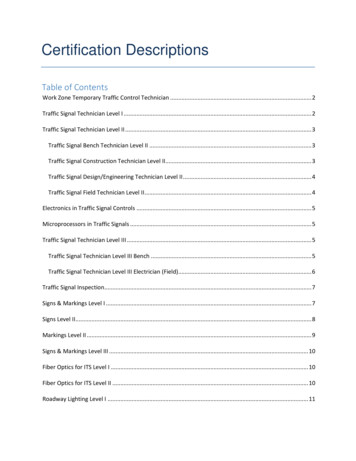
Transcription
Certification DescriptionsTable of ContentsWork Zone Temporary Traffic Control Technician . 2Traffic Signal Technician Level I . 2Traffic Signal Technician Level II . 3Traffic Signal Bench Technician Level II . 3Traffic Signal Construction Technician Level II. 3Traffic Signal Design/Engineering Technician Level II . 4Traffic Signal Field Technician Level II . 4Electronics in Traffic Signal Controls . 5Microprocessors in Traffic Signals . 5Traffic Signal Technician Level III . 5Traffic Signal Technician Level III Bench . 5Traffic Signal Technician Level III Electrician (Field). 6Traffic Signal Inspection. 7Signs & Markings Level I . 7Signs Level II . 8Markings Level II . 9Signs & Markings Level III . 10Fiber Optics for ITS Level I . 10Fiber Optics for ITS Level II . 10Roadway Lighting Level I . 11
Certification DescriptionsWork Zone Temporary Traffic Control TechnicianFeaturing: Part 6 Temporary Traffic Control from the new 2009 MUTCD Edition. Thiscourse includes flagging.Problems of traffic control occur when traffic must be moved through or around road orstreet construction, maintenance operations, utility work and incidents on or adjacent tothe roadway. This manual establishes principles to be observed in the design,installation, and the maintenance of traffic control devices and identifies standardswhere applicable. This study guide was also developed to be used as a reference. Thegeneral principles outlined in this manual are applicable to both rural and urbansituations. This course on Work Zone Traffic Control and Safety was specificallydeveloped by the principles and procedures which experience has shown to enhancethe safety of motorists and the workers in the vicinity of work areas.Printed in full color on a high quality paper, this manual comes in a sturdy 3-ring binderwith tabs for easy reference.Study Guide:Prerequisites:730 pages Copyright 2012NoneBack to TopTraffic Signal Technician Level ITraffic Signal Level I Certification indicates that the holder is familiar with the conceptsand terminology associated with signalized traffic control devices and systems. Thecontent is designed for the entry-level technician that has had some prior training orexperience in electrical technology. Worksite safety is a primary skill area, having beencovered in Work Zone Traffic Control Safety and also in this coursework. Principals ofoperation and the primary electrical details of cabinet wiring and components have beenintroduced. Equipment, methods, and materials of signal system construction havebeen reviewed. The basics of traffic signal design, maintenance, and legal issues havebeen explained and discussed. This certification holder is prepared to make acontribution on any traffic signal crew, whether involved in construction, maintenance, ordesign preparation with proper supervision and guidance. This certification alsoprovides the required background information that will allow the technician to learn thematerial taught in the four Level II certification courses.Study Guide:220 pages Copyright 2011
Prerequisites:IMSA Work Zone Traffic Control Safety Certification or an approvedequivalentOne (1) Year of Experience in the Traffic Signal FieldBack to TopTraffic Signal Technician Level IITraffic Signal Bench Technician Level IIThe Traffic Signal Level II Certification indicates the holder has a well-roundedbackground in traffic signal technology from coursework and experience. The Level IIBench certification indicates the technician has additional training on traffic signalcontrol cabinet equipment. This training includes the programming, application, andmaintenance of controllers, conflict monitors, vehicle and pedestrian detection systems,and the communication and power wiring of the cabinet. The technician is also trainedin electronic circuit operation and fault diagnosis, and the use of test equipment fordiagnosis and certification of control cabinet equipment. The certification holder isprepared to make a substantial contribution in the signal maintenance operation ofeither a private firm or a public agency by preparing signal cabinets for deploymentand/or troubleshooting and repairing cabinet components that are brought in from thefield.Study Guide:Prerequisites:214 pages Copyright 2009IMSA Work Zone Traffic Control Safety Certification or approvedequivalentIMSA Level I Traffic Signal Technician CertificationTwo (2) Years of Experience in the Traffic Signal FieldBack to TopTraffic Signal Construction Technician Level IIThe Traffic Signal Level II Certification indicates the holder has a well-roundedbackground in traffic signal technology from coursework and experience. The Level IIConstruction certification indicates the technician has additional training on traffic signalcontrol system construction, safety, materials, methods, and equipment. Activitiescovered include: safe operation of construction equipment (from concrete saws tocranes), planning activities, documentation, and installation of conduits, poles, mastarms, signal heads, cabinets, and inductive loops. Setup and testing of a new signalinstallation is also reviewed. The certification holder is prepared to make a substantialcontribution in the traffic signal construction group of a private firm or a public agencywhere new or replacement traffic signal construction is the focus.Study Guide:Prerequisites:187 pages Copyright 2009IMSA Work Zone Traffic Control Safety Certification or approvedequivalent
IMSA Level I Traffic Signal Technician CertificationTwo (2) Years of Experience in the Traffic Signal FieldBack to TopTraffic Signal Design/Engineering Technician Level IIThe Traffic Signal Level II Certification indicates the holder has a well-roundedbackground in traffic signal technology from coursework and experience. The Level IIEngineering certification indicates the technician has additional training on traffic signalcontrol system planning, design, theory of operation, and legal/regulatory issues.Areas of training include industry standards, liability and regulatory considerations,traffic data collection, site inspections (prior to signal design), detection design,intersection phasing and timing plans, volume density and coordination timing,equipment selection, and project management. The certification holder is prepared tomake a substantial contribution in the design of signalized intersections, whetheremployed by a private firm or a public agency, where new or replacement traffic signalplanning and design is the focus.Study Guide:Prerequisites:251 pages Copyright 2009IMSA Work Zone Traffic Control Safety Certification or approvedequivalentIMSA Level I Traffic Signal Technician CertificationTwo (2) Years of Experience in the Traffic Signal FieldBack to TopTraffic Signal Field Technician Level IIThe Traffic Signal Level II Certification indicates the holder has a well-roundedbackground in traffic signal technology from coursework and experience. The Level IIField certification indicates the technician has additional training on traffic signal controlsystem troubleshooting, on-site repairs, and maintenance methods and equipment.Areas of training include worksite safety, maintenance of traffic, traffic signal systemequipment standards and operation, installation inspection, troubleshooting, equipmentrepair, replacement and programming, test equipment, signal phasing and timing,detection, system communications, preventive maintenance, and documentation. Thecertification holder is prepared to make a substantial contribution in the maintenanceand repair of signalized intersections, whether employed by a private firm or a publicagency.Study Guide:Prerequisites:266 pages Copyright 2009IMSA Work Zone Traffic Control Safety Certification or approvedequivalentIMSA Level I Traffic Signal Technician CertificationTwo (2) years of experience in the Traffic Signal FieldBack to Top
Electronics in Traffic Signal ControlsThe Electronics in Traffic Signal Controls study guide covers the following basicprinciples: DC Electrical FundamentalsVoltage, current, circuits, source resistance, power, capacitance and inductanceAC Circuit principlesFrequency, capacitors, reactance, and simple filtersInductance, impedance, resonance and transformersSemiconductor electronicsSemiconductor devicesSemiconductor circuitsGlossary of termsStudy Guide:Prerequisites:332 pages Copyright 2004NoneBack to TopMicroprocessors in Traffic SignalsThe Microprocessor in Traffic Signals Study Guide covers the following basic subjects: History of the microprocessorNumber systems and computerarithmeticReview of Boolean algebraReview of integrated circuitsArchitecture of microprocessorsStudy Guide:Prerequisites: MemoryBasics of operationInput and outputProgrammingTroubleshooting401 pages Copyright 2002NoneBack to TopTraffic Signal Technician Level IIITraffic Signal Technician Level III BenchSafety is of utmost importance. Traffic signals are life safety systems and need to beoperated and maintained by only qualified personnel. Technology is changing rapidly inthe traffic signal industry and it takes specialized training to be able to keep up with thetechnology being deployed. Many state and municipal agencies are requiring thatindividuals be IMSA certified to operate and maintain traffic signals.When taking the EITS exam, you must be familiar with the basic principles of:
DC Electrical Fundamentals including Voltage, Current, Circuits, SourceResistance, Power, Capacitance and InductanceAC Circuit Principles including Frequency, Capacitors, Reactance, Simple Filters,Inductance, Impedance, Resonance, and TransformersSemiconductor ElectronicsSemiconductor DevicesSemiconductor CircuitsStudy Guide:Prerequisites:NoneIMSA Work Zone Traffic Control Safety Certification or approvedequivalentIMSA Level II Traffic Signal Technician CertificationMicroprocessor in Traffic Signals CertificationBack to TopTraffic Signal Technician Level III Electrician (Field)What does it cover? The 100 question exam associated with the certification has beenprepared to test the candidate on a wide range of topics relating to field expertise andgeneral knowledge of the applied traffic signal technologies in the field. The following listcontains reference materials that the potential IMSA Traffic Signal Level III – FieldTechnician must be familiar with: NEMA Standards (TS1 and TS2)170/2070 StandardsVarious Traffic Detection Methods (Acoustic, Microwave, Radar, Loops, etc.)Setup and Configuration ManualsVideo Detection Manufacturers Setup ManualsLightening Protection DevicesFHWA and ITE Vehicle Detection ManualsData Communications Methods (Copper, Fiber Optic, Wireless, etc.)U.S. M.U.T.C.D. – 2009 VersionSignal Head Types (Incandescent, L.E.D., Programmable, etc.) specificationsand installation methodsIMSA Wire and Cable SpecificationsITE – Traffic Engineering Manual current editionITE – Traffic Control Devices Handbook current editionTraffic Signal Preemption Devices – Various Manufacturers Operation and SetupManualsUnderstanding of Basic Electronics and ElectricalU.S. – National Electrical Code and/or Canadian Electrical CodeStudy Guide:Prerequisites:NoneIMSA Level II Traffic Signal Electrician Certification IMSATraffic Signal Level III Field CertificationFive (5) Years of Experience in Traffic Signal Field
Back to TopTraffic Signal InspectionThe IMSA Traffic Signal Inspection Certification Program is designed to ensure publicsafety by helping individuals to understand fundamental concepts associated with theinspection for construction of traffic signal installations. Traffic Signals are a key elementin our transportation system and the proper operation of these signals is of paramountimportance in maintaining reasonable levels of mobility. Knowledgeable traffic signalinspection is required to ensure that proper/specified construction practices are followedduring signal installation resulting in signals that operate as intended. Knowledgeableinspection is also a key element in limiting the liability exposure of governmentalagencies associated with malfunctioning traffic signals. Traffic Signal InspectionCertification is recommended for all individuals involved in the inspection of traffic signalconstruction. It is also a valuable course for contractor personnel, since it provides aninspector’s viewpoint of traffic signal construction.Topics covered in the Traffic Signal Inspection Certification Course Manual include: Introduction to Traffic Signal InspectionInspection of Underground FacilitiesInspection of Traffic Signal SupportsInspection of Overhead EquipmentInspection of the Vehicular and Pedestrian Detection SystemsInspection of the Controller AssemblySafety RequirementsFinal Acceptance and Turn-OnAs an addition to the printed manual an interactive version of the Traffic SignalInspection Training Manual is also available on CD ROM.Study Guide:Prerequisites:338 pages Copyright 2008NoneBack to TopSigns & Markings Level IA Level I Signs & Markings Specialist should, by nature of his certification title, havemastered the basic principles behind signing and pavement marking. Although theindividual who is approved to take the Level I exam may have had a lot of fieldexperience, the exam will require that he be able to communicate this knowledge in awritten format. The best way to prepare for this challenge is to begin to review the topicsthat will be covered on the exam. Level I review material has been derived from the
MUTCD. This manual has an overview of traffic control signs and markings, it coversapplications of: Overview of Traffic Control Signsand MarkingsUsing the MUTCDGeneral Introduction to Signs andPavement MarkingsRetroreflectivityCharacteristics of Sign SafetyRegulatory SignsWarning SignsGuide SignsNon Traditional IntersectionSignsSign Installation and MaterialsGeneral Introduction to Markings General Environmental SafetySignsPavement Marking Materials andInstallationSchool Area Traffic ControlBicycle Traffic Control DevicesTODS, Recreation, and CulturalInterest SignSafetyTemporary Traffic Control (TTC)Asset ManagementEquipment ManagementTort LiabilityWorking with the PublicStudy Guide:Copyright 2016Prerequisites:IMSA Work Zone Traffic Control Safety CertificationOne (1) Year of Experience in Signs and/or MarkingsBack to TopSigns Level IIThis course provides the information needed to successfully apply your knowledge ofpractical applications and standard principles in the field. The materials will cover therole of signs in providing drivers with good regulatory, warning, and directionalinformation and ultimately creating safer roadways. This course also presents acceptedindustry practices associated with the design, installation and maintenance of signs.More specifically, the following topics and their significance to day-to-day field work willbe covered: Tort Liability Design and LocationConsiderations Risk Assessment General Warning Signs Regulatory Signs and GeneralPrinciples Special Warning Signs Regulatory Signs: One Way, Ped Object MarkersCrossing, Intersection Maintaining Warning Signs and Nontraditional/Toll/ManagedObject MarkersLanes Freeway Signs Regulatory Signs: Parking and Guide SignsOther Route Markers and Route Signs Warning Signs Street Name Signs Other Signs
General School Area SignsDesign and Installation of SchoolSignsSchool SignsBicycle SignsRoadway and RailsSafety, TTC and EmergencyManagement SignsTODS, Recreation, and CulturalInterest SignsUnderstanding RetroreflectivityStudy Guide:Prerequisites: Applying RetroreflectivitySign Shop ManagementSafety Requirements andHazardous MaterialsMaterial Care and ManagementSign Shop EquipmentManagement and CareAsset Management and InventoryProgramEfficiency Control/Quality ControlSign ShopCopyright 2016IMSA Work Zone Traffic Control Safety Certification IMSASigns and Markings Level I CertificationTwo (2) Years of Experience in Signs and/or MarkingsBack to TopMarkings Level IIThe primary objective of the Level II Markings certification process is to recognize thoseindividuals whose understanding of standard signing and marking principles is thoroughenough to enable them to apply these principles to on-the-job situations. In order toachieve this, the Level II preparation seminar has been designed to emphasize practicalapplication of standard principles. More specifically, the following topics and theirsignificance to day-to-day field work will be covered: Tort liabilityPrinciples of reflectivityRoadways and RailsPavement markingsRoute markers and trailblazer assembliesEquipment maintenanceDealing With The PublicThe future of markingsStudy Guide:Prerequisites:Copyright 2016IMSA Work Zone Traffic Control Safety Certification IMSASigns and Markings Level I CertificationTwo (2) Years of Experience in Signs and/or MarkingsBack to Top
Signs & Markings Level IIISigns and Marking Level III certification is the highest level of certification for signs andmarkings personnel. Signs and Markings Level III has no study guide, but will test yourknowledge of the MUTCD. Attaining the highest level of certification in the signs andmarking’s operation field gives the specialist a profound sense of accomplishment asthe effort required to achieve this goal is exceptional.Study Guide:Prerequisites:NoneIMSA Work Zone Traffic Control Safety CertificationIMSA Signs and Markings Level I CertificationIMSA Signs and Markings Level II CertificationA copy of the latest edition of the MUTCDA copy of NCHRP Synthesis 157: Maintenance and Management ofStreet and Highway SignsFive (5) Years of Verifiable Experience in Signs and/or MarkingsBack to TopFiber Optics for ITS Level IThis new certification program is tailored for those who design, install, and/or maintainIntelligent Transportation Systems (ITS) for city, county, and state transportationdepartments. The course provides a practical understanding of how fiber optics andfiber optic technology is integrated for ITS. The course includes twenty one chaptersfrom theory to systems of which four chapters focus on video transmission, real timevideo, traffic control systems, and next generation systems that are key to the evolutionfrom analog to digital ITS applications. This includes optical multiplexing (WDM,CWDM), bi-directional transmission, and bandwidth considerations for those using orconsidering multimode fibers.Study Guide:Prerequisites:NoneNoneBack to TopFiber Optics for ITS Level IIThis new certification program covers two days of hands on instruction for those whodesign, install, and/or maintain Intelligent Transportation Systems (ITS) for city, countyand state transportation departments.Workstations are set up on the following topics: SplicingCable Preparation
OTDR OperationOptical Loss Testing and SystemsStudy Guide:Prerequisites:NoneFiber Optics for ITS Level I CertificationBack to TopRoadway Lighting Level IThis course originally was Roadway Lighting Level II (Level I and Level II are now Level I). A new RoadwayLighting Level II is being written.The Level 1 Roadway Lighting Certification course for qualified personnel is designed toaid individuals in the understanding fundamental aspects of Roadway Lighting.Additionally, the review material will address electrical safety and codes, basic electricityand laws, and basic construction and maintenance.The following topics and their significance to day-to-day field work will be covered: Safety and QualificationsLamp and Luminaire ComponentsElectrical Service, Poles and Highmast ComponentsBasic Lighting Design FundamentalsLighting ApplicationsMaintenance of SystemsReference DocumentsTesting, Investigation and TroubleshootingAt the conclusion of each of the seminar sections, the participant will be exposed toquestions representative of the type contained in the certification examination.Study Guide:Prerequisites:205 pages Copyright 2012IMSA Work Zone Traffic Control Safety Certification or approvedequivalentOne (1) year of experience in the Roadway Lighting FieldBack to Top
Understanding of Basic Electronics and Electrical U.S. – National Electrical Code and/or Canadian Electrical Code Study Guide: None Prerequisites: IMSA Level II Traffic Signal Electrician Certification IMSA Traffic Signal Level III Field Certifica
